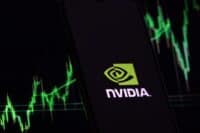

In its recently ended third quarter, Advanced Micro Devices Inc. (NASDAQ: AMD) corralled nearly 25% of the market for Intel-compatible central processing units (CPUs), its second-highest total ever and the sixth consecutive quarter of market share gains for its x86 lineup. Since announcing quarterly results in late October, AMD’s share price has increased by about 22%.
In the graphics processing unit (GPU) market, however, AMD’s market share slipped from 20% to 17% quarter over quarter as Nvidia Inc. (NASDAQ: NVDA) boosted its share by nearly 5%, compared to AMD’s increase of 1.4%. Nvidia now owns 83% of the GPU market.
On Thursday, Bank of America Securities issued an overview of the gaming market that suggests that the two companies’ salad days are not even close to being over. BofA believes that there is plenty of room for both these stocks to run because the upgrade cycle for GPUs is just beginning and promises to be strong.
Based on a review of a monthly hardware survey conducted by Steam, a gaming platform developed by Valve, BofA reports that Steam averaged 47 million daily active users and 90 million monthly active users in 2018. Right now, some 25 million users are online at Steam.
Looking at the latest GPU products from both Nvidia and AMD, the Ampere and Navi lineups, respectively, BofA notes that Ampere products have achieved market penetration of 12.9%, whereas the oldest products (dubbed Pascal) account for 31.5% of Nvidia GPUs currently in use. The Pascal chips were introduced in 2016. Nvidia’s other main chip line (the Turing architecture introduced in 2018) accounts for 36.5% of the company’s installed base. This is a feature, not a bug, according to BofA:
Despite the fact that ~80% of NVDA gamers are using cards released within the last 4-5 years, we think there is sufficient incentive for much of the deployed base of 100mn GeForce GPUs and 200mn GeForce gamers to upgrade. In our estimate, just 22% (up 214 [basis points, month over month], 1074 [basis points year over year) of NVDA Steam users are using graphics cards with specs on par with the Xbox Series X and PS5 game consoles … We define this threshold as equal to or above NVDA’s RTX 2060 Super Turing card. This implies to us 75-80% of the installed base could become strongly motivated to upgrade to higher ASP [average selling price] current-gen[eration] Turing products or next-gen 7nm Ampere products.
The average selling price of the RTX 2060 Super Turing card is $399. The top-of-the-line RTX 3090 Ampere card sells for an average of $1,499.
Steam also tracks its gamers’ CPU choices. Here, the gap between Intel and AMD is closing faster than in the overall market. As of November’s survey, 68.3% of Steam gamers use an Intel CPU while AMD CPUs are the choice of 31.7% of gamers, an all-time high. AMD has gained 80 basis points of market share month over month and 475 basis points year over year.
In addition to its gains in the CPU market, AMD Polaris products, introduced in 2016, remain the company’s most popular GPU card, accounting for 27.5% of AMD’s installed base, while the newer Vega cards account for 13.5% of the installed base and the newest Navi cards contribute 11%.
As of the November survey, 75.3% of Steam gamers use an Nvidia card and 15.4% use an AMD card. In terms of market share, Nvidia’s share slipped by 24 basis points month over month and rose by 148 basis points year over year, while AMD share grew by 19 basis points month over month and fell by 114 basis points year over year.
Even though the gamer market is due for a sharp increase in GPU upgrades, BofA notes the headwinds:
Biggest hurdle remains supply constraints as Ampere [cards] remain completely sold out, and resale premiums have jumped over the last 30 days (now 160% premium vs. 120% in early Nov), likely due to the holiday shopping season. Importantly, as more capacity comes on, we see both unit and ASP tailwinds as Ampere avg. ASP of $493 is 20-70% above prior Turing/Pascal [generations] and well above NVDA avg. $200-$300, while “Big Navi” range $329-$999 is also well above AMD avg. $150-$200.
BofA has reiterated its Buy rating on both AMD and Nvidia. The analysts’ price objectives for AMD and Nvidia are $175 and $375, respectively. At a recent price of around $142.30 per share, the upside potential for AMD stock is 23%. An Nvidia share price of around $304.50 implies a potential gain of 23%. Interestingly, the almost-certain death of Nvidia’s proposed $40 billion acquisition of chip designer Arm does not figure into BofA’s calculation.
Intel’s outlook is a different story. BofA has an Underperform rating on the stock and a price objective of $45. Intel has been trading at around $49.50.
Take This Retirement Quiz To Get Matched With A Financial Advisor (Sponsored)
Take the quiz below to get matched with a financial advisor today.
Each advisor has been vetted by SmartAsset and is held to a fiduciary standard to act in your best interests.
Here’s how it works:
1. Answer SmartAsset advisor match quiz
2. Review your pre-screened matches at your leisure. Check out the
advisors’ profiles.
3. Speak with advisors at no cost to you. Have an introductory call on the phone or introduction in person and choose whom to work with in the future
Take the retirement quiz right here.
Thank you for reading! Have some feedback for us?
Contact the 24/7 Wall St. editorial team.



